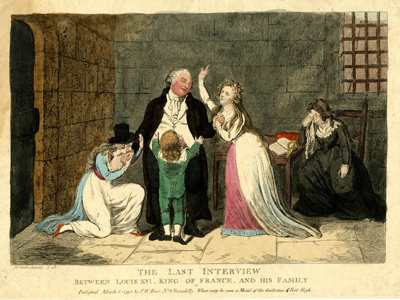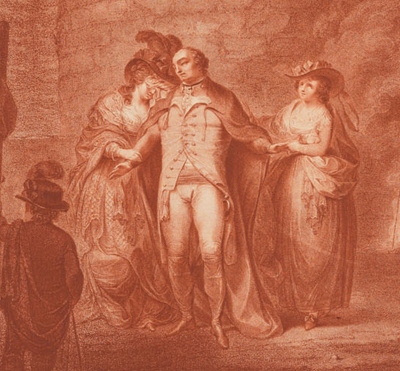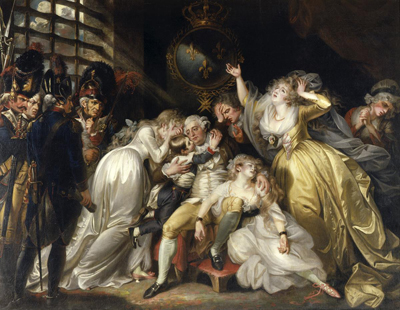Louis XVI Taking Leave of his Wife & Family
When the French King, Louis XVI, was put on trial and ultimately executed on January 21, 1793, there was an almost immediate sea-change in the British reaction to the revolution. Within days of what was called his "murder," and for weeks afterwards, newspapers were filled with accounts of the one-sided trial and the nobility of his final hours. Many accounts spoke of the "martrydom" of the French King, and subscriptions for prints based on paintings of Louis on the scaffold proclaiming his innocence and forgiving his enemies were advertised by numerous publishers and printsellers. There was no doubt that Louis died much better than he lived and reigned.
Gillray's extremely rare print Louis XVI Taking Leave of his Wife & Family consequently represents a departure in several ways.

© Omek Marks, Private Collection
First, it did not come from the shops of Hannah or William Humphrey who had been publishing everything that Gillray had created for the last nine months. Instead, it was offered by J. Aitken who had initially cherished hopes of becoming a first-tier printseller, but whose business was beginning to move in a different (and sketchier) direction.
Second, the focus of the print was no longer on the day of the king's death, but on the previous day when Louis bid farewell to his wife, their children, and his sister—all of whom had been imprisoned with him at the medieval tower of the Temple for the last four months.
This change may have been prompted by the press's (and Gillray's) need to pursue a new but related story line since details of the trial and execution were becoming exhausted. So for the first time on February 28th, there is a story in The London Star about the remaining royal family in the tower. And on March 8th, Isaac Cruikshank, who usually made a living out of plagiarizing Gillray's designs, came out with The Last Interview Between Louis XVI, King of France, and His Family.

The Last Interview Between Louis XVI King of France and His Family [1793]
©Trustees of the British Museum
The print is not a caricature at all, and I can't help but wonder whether Cruikshank remembered Gillray's "serious" print of Coll. Gardiner's Last Interview with his Wife and Daughter (1786). The title and basic visual structure of the prints (full face between two women) are similar, as are the expressions of the women.

©Lewis Walpole Library, Yale University
But what is more important is that Cruikshank's print clearly reflects the idealizing tendencies of a new set of sentimental portrayals of Louis like Mather Brown's painting, The Final Interview of Louis XVI that now begin to appear.

The Final Interview of Louis XVI [1793?]
Building on the almost Christ-like image that had been created of Louis on the scaffold, all of these portray an idealized Louis as husband and father in the midst of and usually embraced by his family.
It is finally in this regard that Gillray's print differs completely from anything that preceded or followed it. Instead of the well-dressed and well coiffured royal family seen in other representations of the scene, Gillray's King and family are only partly shod with bedraggled hair and torn clothes. And Instead of the loving, family man, in the center of a pyramid of affection, Gillray shows a Louis visually enclosed by the monk's cross on one side and the angry revolutionary's musket and bayonet on the other. He stares almost catatonically in front of him gazing at nothing. His fetal-like pose is entirely self-contained: his hands grasp a decanter and glass of wine, his arms are squeezed tightly to his body in complete contrast to the open arms and beseeching gaze of his wife. Instead of the noble, caring, father and husband, remaining strong for his family and country, Gillray portrays a man preparing to drink himself into oblivion, but so terrified that he has lost control of his bowels and can think of no one but himself.
It is not surprising that, subversive as it is, the print was not published by Hannah Humphrey. The Humphrey prints immediately preceding this A View in Perspective. The Zenith of French Glory and The Blood of the Murdered Crying for Vengeance were both very much in keeping with popular sentiment and strongly sympathetic to the French monarch. Gillray's last print with Aitken, however, was A Representation of the Horrid Barbarities Practised upon the Nuns by the Fish-women. . .. As Mathew Crowther describes in a post on his blog, The Printshop Window, the print pretends to a certain outrage with the excesses of the revolution, but with its profusion of bare-bottomed nuns, it is deliberately provocative and titillating, aimed at a very different audience from that of Hannah Humphrey's prints.
That Gillray was himself ambivalent about Louis XVI Taking Leave of his Wife & Family is suggested by the extensive note he included below the image.
The above is an exact copy of an infamous French Print, which has lately appeared in Paris, among numberless others, intended to bring the Conduct of their late Monarch in his last moments, into Contempt & Ridicule; it is now copied and publish'd, in order to hold up a Nation of unfeeling Assassins to that detestation which every true Englishmen must feel for Wretches, who can sport with the sufferings of the unfortunate.
The first part of this note, while a nice dodge of responsibility for the crude portrayal of the French King, is clearly preposterous. It is not difficult to detect when Gillray is working from someone else's drawing or idea as in The Landing of Sir John Bull & His Family, at Boulogne sur mer (1792), based on a drawing by Bunbury. But everything about this print declares that it was created and etched by Gillray himself. The expressions of the long faced monk, the distressed wife and children, and the fatuous guard on the right—all have parallels in other Gillray etchings. And if that were not enough, the prominence of the angry revolutionary literally standing between a pathetic husband and wife, dividing them with his musket, and the irony of the fatuous guard with "Libertas" emblazoned across his bonnet rouge standing next to the iron portcullis of a prison, both declare this is NOT a pro-French print.
It is, as in many of Gillray's prints, distinctly lacking in decorum, especially in its treatment of royalty. But in its ruthless portrayal of a terrified French family confronting certain death at the guillotine (with more than a passing resemblance to England's own George and Charlotte) it may have, in fact, elicited among Gillray's English viewers a greater sympathy for the unfortunate couple and a greater detestation of the "unfeeling assassins" than either of the more decorous and sentimental images of Mather and Cruikshank.
Sources and Reading
- Draper Hill, Mr. Gillray The Caricaturist, 1965, p. 44, Pl.46
- For James Aitken, see the article about him on the blog by Mathew Crowther, The Printshop Window.
- For the final hours of Louis XVI, see 21st of January 1793: execution of Louis XVI on the blog Versailles and More.
Comments & Corrections
NOTE: Comments and/or corrections are always appreciated. To make that easier, I have included a form below that you can use. I promise never to share any of the info provided without your express permission.